- Cleoma: The Ultimate Guide
- Introduction
- Growing Cleoma from Seeds
- Types and Varieties of Cleoma
- Tips for Growing Cleoma
- Conclusion
- Growing Cleoma from Seeds: Step-by-Step Guide
- Step 1: Obtain the seeds
- Step 2: Prepare the soil
- Step 3: Sow the seeds
- Step 4: Water regularly
- Step 5: Provide support
- Step 6: Thin out the seedlings
- Step 7: Mulch and fertilize
- Step 8: Monitor for pests and diseases
- Step 9: Harvesting and saving seeds
- Choosing the Right Type of Cleoma for Your Garden
- 1. Climate
- 2. Height and Spread
- 3. Flower Color
- 4. Growing Habit
- 5. Maintenance Requirements
- Exploring the Beautiful Varieties of Cleoma
- Pink Queen Cleoma
- White Queen Cleoma
- Senorita Rosalita Cleoma
- Sparkler Blush Cleoma
- Linda Cleoma
- The Importance of Proper Cleoma Care
- 1. Optimal Growth and Blooming
- 2. Disease Prevention
- 3. Longevity and Productivity
- 4. Aesthetic Appeal
- 5. Eco-Friendliness
- Common Pest and Disease Issues for Cleoma
- Pests
- Diseases
- Tips for Successful Cleoma Propagation
- 1. Start with high-quality seeds
- 2. Prepare the soil
- 3. Sow the seeds at the right time
- 4. Provide optimal growing conditions
- 5. Thin the seedlings
- 6. Fertilize regularly
- 7. Watch out for pests and diseases
- 8. Harvest and collect seeds
- Harvesting Cleoma Seeds for Future Planting
- 1. Timing
- 2. Tools
- 3. Collection
- 4. Drying
- 5. Cleaning
- 6. Storing
- Using Cleoma in Landscaping and Floral Arrangements
- Landscaping with Cleoma
- Floral Arrangements with Cleoma
- Tips for Growing Cleoma
- Questions and Answers:
- What is cleoma?
- How to grow cleoma from seeds?
- What are the different types of cleoma?
- What are some popular varieties of cleoma?
- What is the ideal growing conditions for cleoma?
- Is cleoma a low maintenance plant?
- Videos: How to grow Cleome Hassleriana (spider flower) from seed
Cleoma, also known as spider flower, is a stunning flowering plant that can add a touch of beauty and elegance to any garden or landscaping project. With its unique spider-like flowers and tall, slender stems, Cleoma is sure to attract attention and admiration. In this expert guide, we will explore everything you need to know about growing Cleoma from seeds, including the different types and varieties available.
When it comes to growing Cleoma from seeds, there are a few important factors to consider. First and foremost, Cleoma seeds should be sown directly into the ground as they do not transplant well. It is best to sow the seeds in a sunny location with well-drained soil. Cleoma is a hardy plant that can tolerate a wide range of soil conditions, but it prefers a slightly acidic soil pH.
There are several types and varieties of Cleoma to choose from, each with its own unique characteristics. The most common type is Cleome hassleriana, which features pink, purple, or white flowers and can reach heights of up to 4 feet. Other popular varieties include Cleome spinosa, which has smaller flowers and a more compact growth habit, and Cleome gynandra, which is native to Africa and features yellow flowers.
In summary, Cleoma is a beautiful and versatile flowering plant that can be grown from seeds. With its stunning spider-like flowers and tall, slender stems, Cleoma is sure to make a statement in any garden or landscaping project. By following our expert guide, you can successfully grow Cleoma from seeds and enjoy its beauty for years to come.
Cleoma: The Ultimate Guide
Introduction
Cleoma, also known as spider flower, is a versatile and beautiful plant that can be grown from seeds. This ultimate guide will provide you with all the information you need to know about cleoma, including how to grow it from seeds, types and varieties, and expert tips.
Growing Cleoma from Seeds
If you want to grow cleoma in your garden, the best way is to start it from seeds. Here are the steps to grow cleoma from seeds:
- Choose a well-draining location with full sun or partial shade.
- Prepare the soil by removing any weeds or rocks and loosening it with a garden fork.
- Sow the cleoma seeds directly into the soil, spacing them about 12 inches apart.
- Cover the seeds lightly with soil and water gently.
- Keep the soil consistently moist until the seeds germinate, which usually takes about 10-14 days.
- Once the seedlings have grown a few inches tall, thin them out, leaving only the strongest plants.
- Continue to water regularly and provide support if needed as the plants grow.
- Cleoma will start to bloom in mid to late summer, and you can enjoy their beautiful flowers throughout the season.
Types and Varieties of Cleoma
Cleoma comes in different types and varieties, offering a range of flower colors and growth habits. Some popular types of cleoma include:
- Cleoma hassleriana: This is the most commonly grown variety and features pink, purple, or white flowers.
- Cleoma spinosa: This variety has white or pink flowers and is known for its spiky foliage.
- Cleoma pungens: Also known as “Giant spider flower,” this variety produces large flowers in shades of pink and purple.
Tips for Growing Cleoma
Here are some expert tips for growing cleoma:
- Choose a location with good air circulation to avoid disease problems.
- Water cleoma regularly to keep the soil evenly moist, but avoid overwatering.
- Deadhead spent flowers to encourage continuous blooming.
- Apply a balanced fertilizer once a month during the growing season to promote healthy growth.
- Protect young cleoma plants from slugs and snails by using organic pest control methods.
Conclusion
Cleoma is a beautiful and easy-to-grow plant that can add a touch of elegance to any garden. By following the steps to grow it from seeds and implementing the expert tips, you can enjoy the vibrant flowers of cleoma throughout the summer season.
Growing Cleoma from Seeds: Step-by-Step Guide
Growing cleoma from seeds can be a rewarding and enjoyable experience. Here is a step-by-step guide to help you successfully grow cleoma from seeds:
Step 1: Obtain the seeds
Start by obtaining cleoma seeds. You can purchase them from a reputable nursery or garden center, or you can collect seeds from an existing cleoma plant if you have one.
Step 2: Prepare the soil
Cleoma prefers well-draining soil and full sun. Prepare the soil by removing any weeds or debris and loosening it with a garden fork or tiller. Add organic matter, such as compost or aged manure, to improve the soil’s fertility and drainage.
Step 3: Sow the seeds
Choose a location in your garden or prepare containers for sowing the seeds. Cleoma seeds can be sown directly in the ground or started indoors in pots. If sowing indoors, use seed-starting mix and plant the seeds 1/4 inch deep, gently covering them with soil. If sowing outdoors, sow the seeds directly in the prepared soil.
Step 4: Water regularly
Keep the soil consistently moist but not waterlogged. Water the seeds gently using a watering can or a gentle spray nozzle on a hose. Avoid overwatering, as this can lead to root rot.
Step 5: Provide support
Cleoma can grow quite tall, so providing support is important to prevent the plants from falling over. You can use stakes or a trellis to support the plants as they grow. Install the support system early on to avoid damaging the plant later.
Step 6: Thin out the seedlings
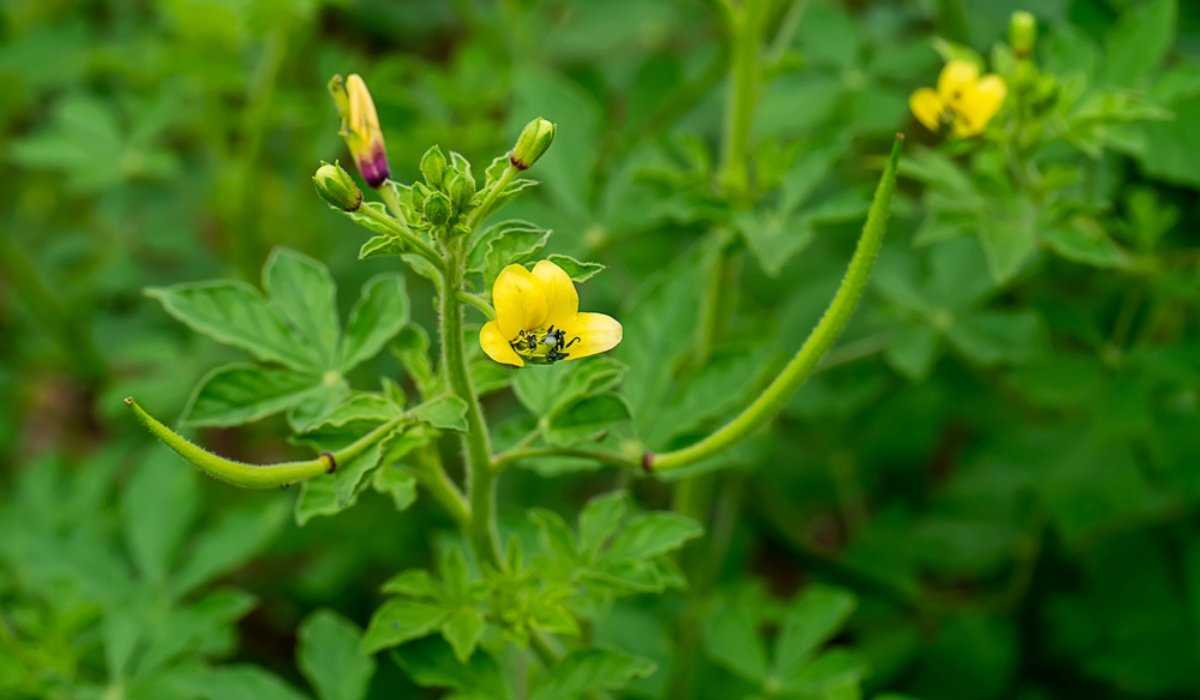
Once the seedlings have emerged, thin them out to provide adequate spacing for the plants to grow. Space the cleoma seedlings according to the spacing requirements provided on the seed packet or label.
Step 7: Mulch and fertilize
Apply a layer of mulch around the plants to help retain moisture and suppress weeds. Additionally, fertilize the plants every four to six weeks with a balanced fertilizer to promote healthy growth and flowering.
Step 8: Monitor for pests and diseases
Regularly inspect your cleoma plants for any signs of pests or diseases. Common pests that can affect cleoma include aphids and spider mites. Treat any pest or disease issues promptly to prevent them from spreading or causing significant damage to the plants.
Step 9: Harvesting and saving seeds
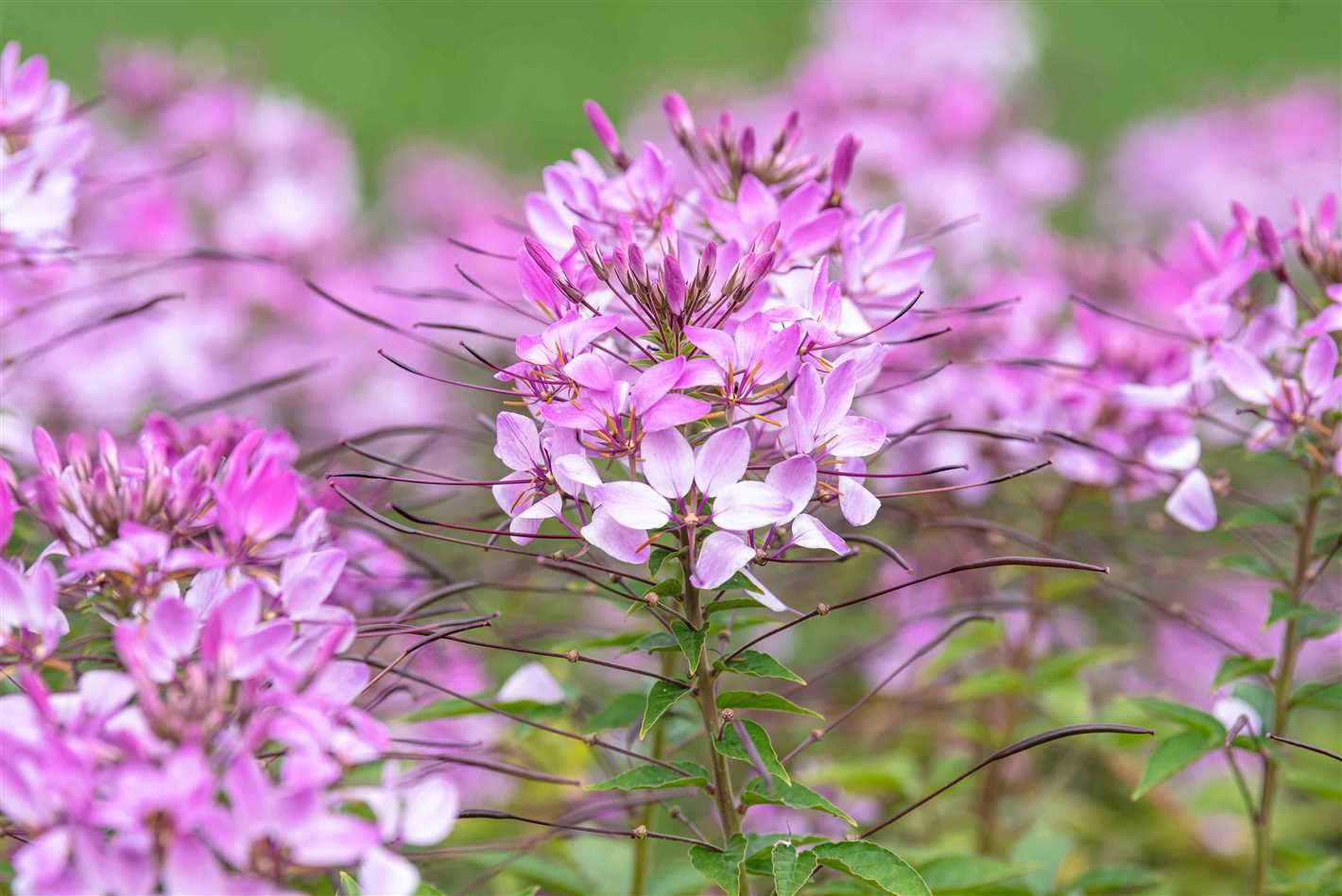
Once the cleoma plants have flowered, you can harvest the seeds by allowing the seed pods to fully mature on the plant. Once the pods have dried and turned brown, carefully remove them and collect the seeds. Store the seeds in a cool, dry place for future use.
By following these step-by-step instructions, you can successfully grow cleoma from seeds and enjoy their beautiful flowers in your garden. Happy gardening!
Choosing the Right Type of Cleoma for Your Garden
Growing Cleoma in your garden can add a beautiful touch to your landscape with its vibrant colors and unique flowers. However, with numerous varieties available, it can be challenging to choose the right type of Cleoma for your garden. Here are some factors to consider when selecting the perfect Cleoma variety:
1. Climate
One of the essential factors to consider is the climate in your region. Cleoma plants thrive in warm weather and require full sun exposure to produce healthy blooms. If you live in a colder climate, it is best to choose Cleoma varieties that are more cold-tolerant.
2. Height and Spread
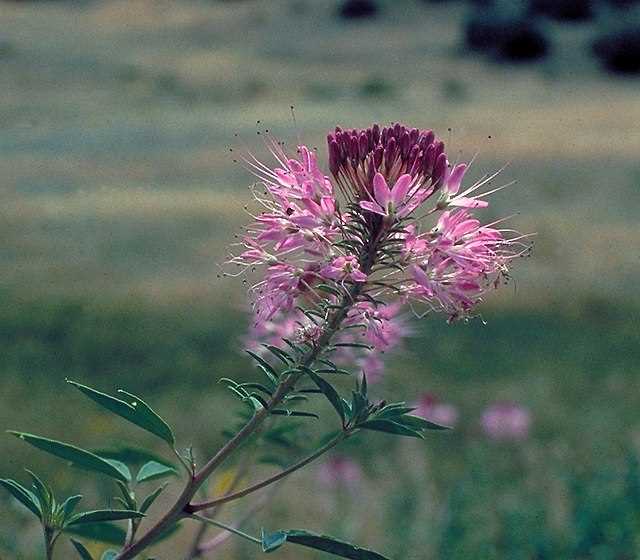
Cleoma plants come in different sizes, so it is important to consider the height and spread of the variety you choose. Some varieties can grow as tall as 6 feet, while others are more compact and reach only a few feet in height. Consider the available space in your garden and select a Cleoma variety that fits well.
3. Flower Color
Cleoma flowers come in a wide range of colors, including pink, white, purple, and even bi-colored varieties. Consider the color scheme of your garden and choose a Cleoma variety that complements the existing flowers and plants.
4. Growing Habit
Some Cleoma varieties have a bushier growing habit, while others have a more upright and slender form. Consider how you want to incorporate Cleoma in your garden design and choose a variety that suits your preferences.
5. Maintenance Requirements
Cleoma plants are generally low-maintenance, but some varieties may require more care than others. Consider your level of gardening experience and the amount of time you can dedicate to plant care. Select a Cleoma variety that fits your maintenance capabilities.
By considering these factors, you can choose the right type of Cleoma that will thrive in your garden and add beauty to your outdoor space.
Exploring the Beautiful Varieties of Cleoma
Cleoma, also known as spider flower or Rocky Mountain bee plant, is a versatile and beautiful flowering plant that comes in a variety of stunning varieties. Each variety boasts unique characteristics and colors, offering gardeners a wide range of options to choose from. Below, we explore some of the most popular and visually appealing varieties of Cleoma.
Pink Queen Cleoma
Pink Queen Cleoma is a well-loved variety known for its stunning pink flowers. These flowers have a vibrant hue that stands out in any garden or landscape. The Pink Queen Cleoma also boasts a long blooming period, ensuring that your garden stays filled with color for extended periods.
White Queen Cleoma
White Queen Cleoma is a mesmerizing variety that showcases pure white flowers. The contrast between the white blooms and the plant’s green foliage creates an eye-catching display. This variety’s elegant flowers provide a touch of sophistication to any garden or floral arrangement.
Senorita Rosalita Cleoma
Senorita Rosalita Cleoma is a popular variety known for its compact growth habit and profusion of vibrant pink flowers. This variety is particularly well-suited for smaller gardens or containers, as it grows to a moderate height and requires minimal maintenance. Senorita Rosalita Cleoma attracts pollinators and provides a continuous show of color throughout the season.
Sparkler Blush Cleoma
Sparkler Blush Cleoma is a unique variety that features bi-colored flowers with white and pink petals. The contrast between the two colors creates a visually stunning display, adding interest and charm to any garden. This variety also boasts a compact habit and a long flowering period, making it a great choice for both beginner and experienced gardeners.
Linda Cleoma
Linda Cleoma is a standout variety known for its striking purple flowers. These vibrant blooms add a pop of color to any garden or landscape. Linda Cleoma is also highly attractive to butterflies and other pollinators, making it an excellent choice for those looking to create a wildlife-friendly garden.
These are just a few examples of the beautiful varieties of Cleoma available to gardeners. Whether you prefer vibrant pinks, pure whites, bi-colored blooms, or striking purples, there is sure to be a Cleoma variety that suits your preferences and enhances the beauty of your garden.
The Importance of Proper Cleoma Care
Cleoma is a beautiful flowering plant that requires proper care to thrive and bloom. By providing the right conditions and attention, you can ensure the health and longevity of your cleoma plants. Here are the key reasons why proper care is important:
1. Optimal Growth and Blooming
Proper care includes providing cleoma with the right amount of sunlight, water, and nutrients. Cleoma plants thrive in full sun, so make sure they receive at least 6-8 hours of direct sunlight each day. Water the plants regularly, keeping the soil moist but not soggy. In terms of nutrients, a balanced fertilizer can help promote healthy growth and abundant blooming. With proper care, your cleoma plants will grow vigorously and produce beautiful flowers.
2. Disease Prevention
Healthy cleoma plants are less susceptible to diseases and pests. By providing proper care, you can strengthen the plants’ immune systems and reduce the risk of common problems such as powdery mildew, aphids, or spider mites. Regularly inspect your plants for any signs of disease or pests, and take immediate action if needed. Keeping the plants healthy and disease-free will ensure their longevity and beauty.
3. Longevity and Productivity
Cleoma plants can live for several years if properly cared for. By providing the right conditions, you can extend the lifespan of your cleoma plants and enjoy their beauty year after year. Regular pruning and deadheading can also help maintain the plants’ shape and encourage continuous blooming. Additionally, proper care can improve the plants’ productivity, resulting in more flowers and seeds for propagation.
4. Aesthetic Appeal
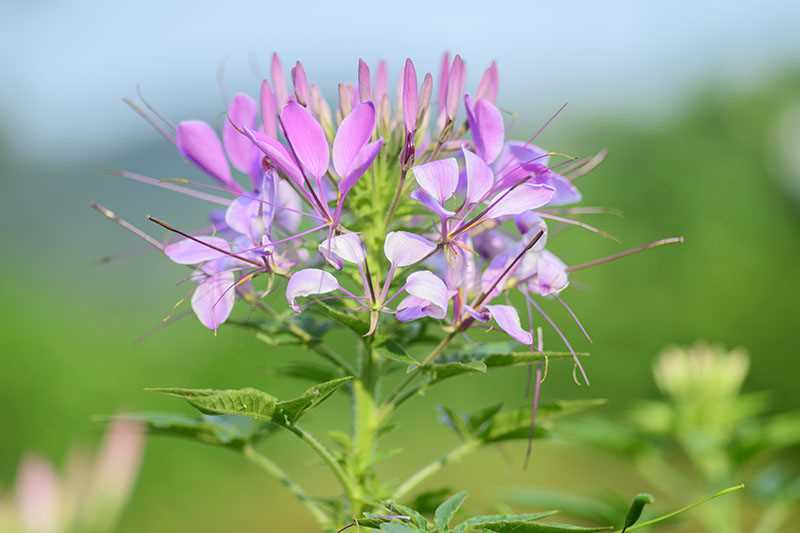
Proper care not only ensures the health and longevity of cleoma plants but also enhances their aesthetic appeal. Well-cared-for cleoma plants will have lush foliage and abundant, vibrant flowers, adding beauty and color to your garden or landscape. Regular watering, fertilizing, and pruning will keep the plants looking their best and make them a standout feature in any outdoor space.
5. Eco-Friendliness
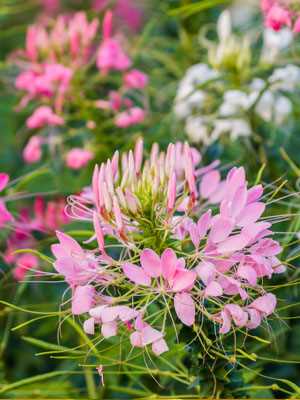
Providing proper care for your cleoma plants can have environmental benefits as well. These plants attract pollinators such as bees and butterflies, contributing to a healthy and diverse ecosystem. By creating a welcoming environment for these beneficial insects, you are promoting biodiversity and helping to sustain the natural balance in your garden or surrounding area.
In conclusion, proper care is crucial for the health, longevity, and beauty of cleoma plants. By providing the right conditions and attention, you can ensure optimal growth, disease prevention, longevity, and productivity. Additionally, well-cared-for cleoma plants enhance the aesthetic appeal of your outdoor space and contribute to a more eco-friendly environment.
Common Pest and Disease Issues for Cleoma
Cleoma plants are generally resistant to most pests and diseases, but they can still be susceptible to a few common issues.
Pests
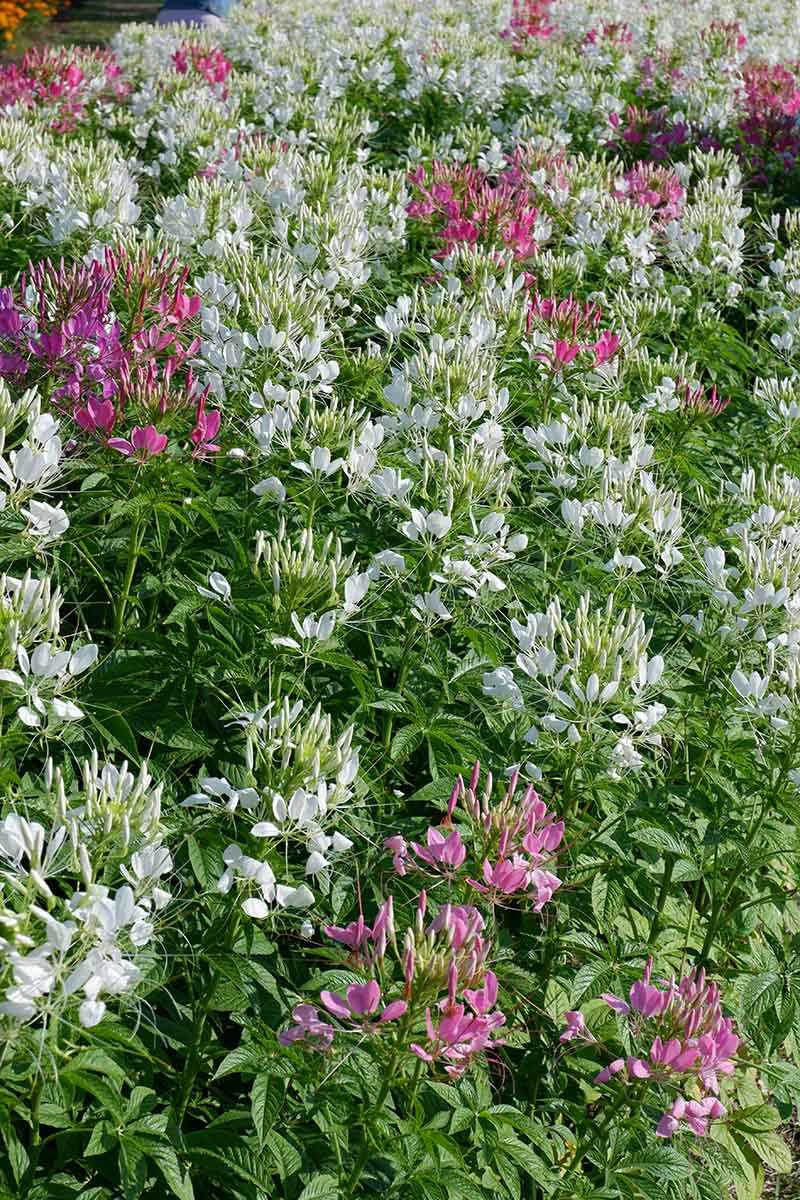
- Aphids: These small insects can suck the sap from the leaves and stems of Cleoma plants. Regularly inspect your plants for aphid infestations and use insecticidal soap or neem oil to control them.
- Caterpillars: Certain types of caterpillars, such as cabbage loopers or tomato hornworms, can feed on the leaves of Cleoma plants. Handpick the caterpillars off the plants and destroy them or use an organic caterpillar control product.
- Spider Mites: These tiny pests can leave a fine webbing on the leaves of Cleoma plants and cause damage. Use a strong stream of water to dislodge them or apply insecticidal soap.
Diseases
- Powdery Mildew: This fungal disease can cause a white powdery coating on the leaves of Cleoma plants. Ensure proper spacing and air circulation between plants to prevent powdery mildew. If it does occur, use a fungicidal spray or sulfur dust to control it.
- Fusarium Wilt: This soil-borne fungal disease can cause wilting and yellowing of the leaves in Cleoma plants. Plant resistant varieties and avoid planting in soil previously affected by Fusarium wilt.
- Gray Mold: Also known as Botrytis blight, this fungal disease can cause brown spots and fuzzy gray mold on the flowers and foliage of Cleoma plants. Remove and destroy infected plant parts and use a fungicidal spray to prevent its spread.
Proper cultural practices, such as providing adequate sunlight, water, and nutrients, can help strengthen Cleoma plants and make them more resistant to pests and diseases. Regular monitoring and quick action at the first sign of trouble can also help maintain the health and vigor of your Cleoma plants.
Tips for Successful Cleoma Propagation
Propagating cleoma from seeds is a rewarding and relatively simple process. Follow these tips to ensure successful cleoma propagation:
1. Start with high-quality seeds
Use fresh cleoma seeds that are free from disease and damage. This will increase the chances of germination and produce healthier plants.
2. Prepare the soil
Cleoma prefers well-draining soil with a pH level of 6.0 to 7.0. Amend the soil with organic matter such as compost to improve its fertility and drainage.
3. Sow the seeds at the right time
Start sowing cleoma seeds indoors 6 to 8 weeks before the last frost date or directly in the garden after the last frost. This will ensure that the seedlings have enough time to grow before the growing season starts.
4. Provide optimal growing conditions
Cleoma thrives in full sun conditions but can tolerate partial shade. Make sure to provide the plants with at least 6 hours of direct sunlight daily. Keep the soil evenly moist but avoid overwatering, as cleoma is prone to root rot.
5. Thin the seedlings
When the seedlings have grown to about 2 inches tall, thin them out to ensure proper spacing. Cleoma plants need enough room to grow and good air circulation to prevent diseases.
6. Fertilize regularly
Feed the cleoma plants with a balanced fertilizer every 4-6 weeks during the growing season. This will provide the necessary nutrients for healthy growth and abundant flowering.
7. Watch out for pests and diseases
Cleoma is generally resistant to pests and diseases, but it can occasionally be attacked by aphids, spider mites, or powdery mildew. Monitor your plants regularly and take appropriate action if any issues arise.
8. Harvest and collect seeds
Allow some cleoma flowers to mature and dry on the plant. Collect the seeds and store them in a cool, dry place for future use. This will ensure a continuous supply of cleoma seeds for propagation.
By following these tips, you can successfully propagate cleoma from seeds and enjoy the beauty of these unique and colorful flowers in your garden.
Harvesting Cleoma Seeds for Future Planting
Harvesting cleoma seeds is an essential part of growing this beautiful flower. When the cleoma plant reaches its peak and the flowers start to fade, it’s time to start collecting the seeds for future planting. By harvesting the seeds, you can ensure a consistent supply of cleoma plants year after year.
1. Timing
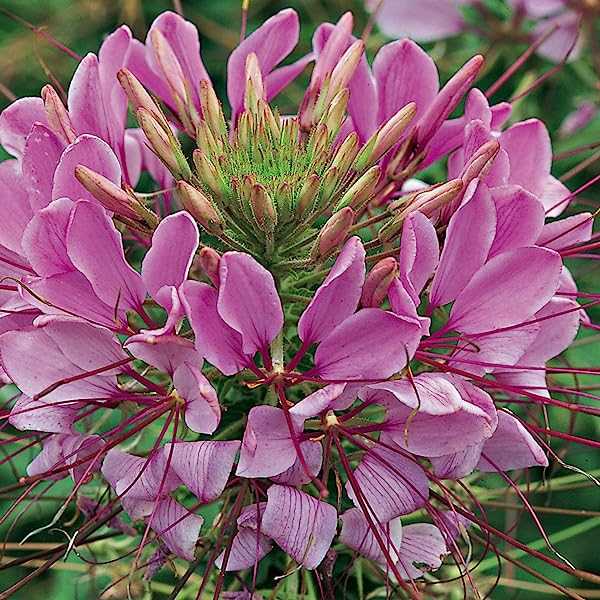
The best time to harvest cleoma seeds is after the flowers have faded and turned brown. This usually occurs in late summer or early fall, depending on your location. It’s important to wait until the seed pods have fully matured before harvesting the seeds.
2. Tools
You don’t need any special tools to harvest cleoma seeds. All you need are a pair of gloves and a pair of scissors or pruning shears. The gloves will protect your hands from the thorny stems of the cleoma plant, while the scissors or pruning shears will help you cut the seed pods.
3. Collection
To collect cleoma seeds, start by identifying the seed pods. They are small, elongated pods that form after the flowers have faded. They will be brown and papery in texture. Cut the seed pods from the plant, making sure to leave a short stem attached. Place the seed pods in a paper bag or envelope to allow them to dry further.
4. Drying
Once you have collected the cleoma seed pods, it’s important to allow them to dry completely before storing them. Place the seed pods in a cool, dry location with good air circulation. Avoid exposing them to direct sunlight or high humidity, as this can affect their viability.
5. Cleaning
After the seed pods have dried for a week or two, it’s time to clean the seeds. Gently crush the seed pods to release the seeds. You can do this by rolling the pods between your fingers or using a pestle and mortar. Separate the seeds from the pod debris and store them in a dry, airtight container.
6. Storing
Store the harvested cleoma seeds in a cool, dark place until you are ready to plant them. Make sure to label the container with the date of harvesting and the variety of cleoma. Properly stored cleoma seeds can remain viable for several years, allowing you to start new plants whenever you want.
By following these steps, you can successfully harvest and store cleoma seeds for future planting. Enjoy the process and reap the rewards of growing your own beautiful cleoma plants.
Using Cleoma in Landscaping and Floral Arrangements

Cleoma, also known as spider flower, is a versatile plant that can be used in various landscaping and floral arrangements. Its unique and delicate appearance adds a touch of elegance to any space.
Landscaping with Cleoma
When it comes to landscaping, Cleoma can be planted in flower beds, borders, and containers, adding height and texture to the overall design. Here are some tips for using Cleoma in landscaping:
- Plant Cleoma along fences or trellises to create a beautiful vertical accent.
- Combine Cleoma with other plants that have contrasting colors and textures to create visual interest.
- Use Cleoma as a centerpiece in a flower bed, surrounded by low-growing plants for a dramatic effect.
- Consider planting Cleoma near seating areas or walkways to enjoy its fragrance and beauty up close.
Floral Arrangements with Cleoma
Cleoma’s long, slender stems and delicate flowers make it a popular choice for floral arrangements. Here are some ideas for incorporating Cleoma into your flower arrangements:
- Use Cleoma as a focal point in a bouquet, surrounded by smaller flowers and foliage.
- Combine Cleoma with other tall flowers, such as gladiolus or snapdragons, for a dramatic arrangement.
- Add Cleoma to a vase filled with greenery and other colorful flowers for a stunning centerpiece.
- Create a unique flower crown or garland using Cleoma’s long stems.
Tips for Growing Cleoma
If you plan to use Cleoma in your landscaping or floral arrangements, here are some tips for growing this beautiful plant:
- Plant Cleoma seeds in well-drained soil in a sunny location.
- Water Cleoma regularly, keeping the soil moist but not waterlogged.
- Deadhead faded flowers to encourage continuous blooming.
- Protect Cleoma from strong winds, as its tall stems can be easily damaged.
- Consider growing Cleoma from transplants for faster and more consistent results.
With its unique appearance and versatility, Cleoma is a great addition to any landscaping or floral arrangement. Whether you plant it in your garden or use it in a bouquet, Cleoma is sure to add beauty and elegance to your space.
Questions and Answers:
What is cleoma?
Cleoma is a flowering plant native to the Americas. It is also known as spider flower due to its long, thin petals resembling spider legs.
How to grow cleoma from seeds?
To grow cleoma from seeds, start by sowing the seeds indoors 6-8 weeks before the last frost date. Plant the seeds in a well-draining potting mix and keep them moist. Once the seedlings have developed 2-3 sets of true leaves, they can be transplanted outdoors after the danger of frost has passed.
What are the different types of cleoma?
There are several different types of cleoma, including Cleoma hassleriana and Cleoma pungens. Cleoma hassleriana, also known as the Rocky Mountain beeplant, is the most common type and is often grown for its attractive flowers. Cleoma pungens, on the other hand, is a prickly species that is known for its ability to deter pests.
What are some popular varieties of cleoma?
Some popular varieties of cleoma include ‘Queen Mix’, ‘Violet Queen’, and ‘Rose Queen’. These varieties are known for their beautiful flowers in a range of colors, including pink, purple, and white.
What is the ideal growing conditions for cleoma?
Cleoma thrives in full sun and well-draining soil. It prefers a pH level of 5.5-7.0 and can tolerate a wide range of soil types. Cleoma is also drought-tolerant and can withstand hot temperatures, making it a great choice for gardens in warm climates.
Is cleoma a low maintenance plant?
Yes, cleoma is considered a low maintenance plant. It is relatively easy to grow from seeds and does not require much attention once established. Cleoma is also resistant to most pests and diseases, making it a hassle-free addition to any garden.







